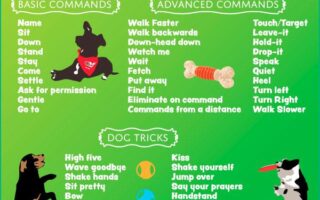Unlocking Canine Communication: The Art of Dog Button Training
In an age where technology seamlessly intertwines with daily life, our furry companions are also finding new ways to express their thoughts and needs. Dog button training, a fascinating method that employs customizable sound buttons, is transforming the way we understand and interact with our canine friends. Gone are the days when we relied solely on barks and body language; now, with the tap of a paw, dogs are gaining an unprecedented platform to communicate their desires. Whether it’s asking for a walk, expressing hunger, or simply saying “I love you,” this innovative training technique opens up a world of possibilities for deeper connection and enriched companionship between dog and owner. In this article, we will explore the principles and practices of dog button training, its benefits, and tips on how to embark on this rewarding journey of canine communication. Join us as we delve into a world where every button press becomes a conversation, and every wag of the tail is a step toward understanding.
Table of Contents
- Exploring the Basics of Dog Button Training
- Mastering Communication: Choosing the Right Buttons
- Tips for Effective Button Training Sessions
- Troubleshooting Common Challenges in Button Training
- Q&A
- Final Thoughts
Exploring the Basics of Dog Button Training
Dog button training is an innovative and fun way to enhance communication between you and your furry friend. This method involves teaching your dog to use specially designed buttons to express their needs and desires. By pressing these buttons, your dog can convey a variety of messages, such as wanting to go outside, play, or even asking for food. The process starts with introducing your dog to the buttons, allowing them to explore and familiarize themselves with the sounds and responses that follow each press. Consistency and positive reinforcement are key to success, helping your dog understand the connection between their actions and the resulting outcomes.
To get started, consider using the following tips to effectively train your dog:
- Choose engaging buttons: Select buttons that are colorful, easy to press, and have different sounds to keep your dog interested.
- Use clear labels: Label each button with a word or image that accurately represents the action or item your dog is trying to communicate.
- Practice regularly: Spend a few minutes each day working with your dog, reinforcing their learning and building their confidence.
- Be patient: Understand that each dog learns at their own pace, and remain supportive throughout the training process.
| Button Purpose | Suggested Label |
|---|---|
| Go Outside | “Outside” |
| Playtime | “Play” |
| Hunger | “Food” |
| Water | “Drink” |
Mastering Communication: Choosing the Right Buttons
When embarking on the adventure of dog button training, selecting the right buttons is crucial for effective communication between you and your canine companion. Buttons serve as a bridge, allowing your furry friend to express their needs and desires clearly. Consider these factors when choosing buttons:
- Size and Shape: Select buttons that are easy for your dog to press, ensuring they are large enough for their paws or noses.
- Feedback: Opt for buttons that provide auditory or tactile feedback, helping your dog learn the association between pressing and communication.
- Durability: Choose robust buttons designed to withstand enthusiastic pawing and potential chewing.
To further enhance the training experience, consider organizing your buttons based on specific categories of communication. A thoughtful arrangement can help your dog navigate their options more intuitively. Below is a simple table illustrating potential categories and their corresponding buttons:
| Category | Button Suggestion |
|---|---|
| Basic Needs | Food, Water, Outside |
| Playtime | Toy, Walk, Fetch |
| Affection | Pet Me, Cuddle, Belly Rub |
Tips for Effective Button Training Sessions
When engaging in button training with your dog, it’s essential to create an environment that fosters focus and understanding. Begin your sessions in a distraction-free space to help your dog concentrate. Keep the training sessions short and fun to maintain their interest—around 5 to 10 minutes is optimal for younger or easily distracted dogs. Additionally, always use positive reinforcement by rewarding your dog immediately after they press a button correctly, whether with treats, praise, or toys. This encourages them to associate the act of pushing the button with something delightful.
Incorporating variety into your training can keep your dog motivated. Consider using a mix of different buttons that represent various actions or words, such as “outside,” “play,” or “food.” This will help them learn context and enhance communication. Track your dog’s progress through a simple table to monitor which buttons they understand well and which require more attention:
| Button | Status | Notes |
|---|---|---|
| Outside | Learned | Presses consistently when wanting a walk. |
| Play | In Progress | Presses occasionally; needs more repetition. |
| Food | Learned | Presses whenever hungry. |
Troubleshooting Common Challenges in Button Training
When diving into button training, it’s common to face several hurdles that can hinder progress. Inconsistent responses from your dog can stem from a lack of clarity in the button prompts. To mitigate this, ensure that each button is distinctly associated with a specific action or need. Use a defined set of buttons at first. Here are some ideas to enhance consistent usage:
- Limit buttons to the most essential needs initially, such as “potty,” “hungry,” and “play.”
- Introduce one button at a time to prevent overwhelming your dog.
- Reinforce button usage with positive rewards each time your dog uses a button correctly.
Another challenge can be your own timing and setup. If you’re not consistently present or attentive when training, your dog may struggle. Documenting training sessions can be beneficial; keeping a journal helps you understand what works and what doesn’t. Consider this simple table highlighting common timing pitfalls:
| Timing Issue | Solution |
|---|---|
| Inconsistent reinforcement | Establish a specific routine or schedule for training. |
| Ignoring button presses | Practice being observant and respond promptly. |
| Training in distracting environments | Begin training in a quiet space before progressing to more stimulating surroundings. |
Q&A
Q&A on Dog Button Training
Q: What is dog button training?
A: Dog button training is an innovative method that involves teaching dogs to communicate using specially designed buttons that emit recorded phrases when pressed. Each button corresponds to a specific word or phrase, allowing dogs to express their needs and feelings in a more human-like manner.
Q: How does button training work?
A: The process begins by introducing your dog to the buttons, each labeled with a word like “outside,” “play,” or “hungry.” Through positive reinforcement, like treats and praise, you guide your dog to understand the meaning of each button. Over time, with consistent practice, your dog learns to associate the action of pressing a button with a desire or need.
Q: What are the benefits of dog button training?
A: One of the primary benefits is enhanced communication between you and your dog. This method can reduce frustration for both parties as your dog becomes more expressive about its needs. Button training can also strengthen your bond, provide mental stimulation, and encourage a more enriching environment for your dog.
Q: Is any dog suitable for button training?
A: Most dogs can benefit from button training, regardless of breed or age. However, the effectiveness may vary depending on your dog’s personality and willingness to engage with the training process. Positive reinforcement and patience are key components, so dogs that respond well to these methods will likely thrive.
Q: How long does it typically take for a dog to learn to use the buttons?
A: The timeline can vary widely; some dogs may pick it up in a few days, while others might take weeks or even months. It largely depends on the individual dog’s learning pace, prior training experience, and the consistency of practice. Regular short training sessions are generally more effective than lengthy, sporadic ones.
Q: What are some common challenges in dog button training?
A: Some common challenges include a lack of interest from the dog, misunderstanding the buttons’ meanings, or pressing buttons out of curiosity rather than intent. To mitigate these issues, ensure the training sessions are engaging, keep the buttons easily accessible, and remain patient as your dog learns.
Q: Can button training address specific behavioral issues?
A: Yes, dog button training can help address specific behavioral issues by providing a channel for communication. For instance, a dog that feels anxious can use buttons to express its needs instead of resorting to unwanted behaviors. Over time, this improves overall behavior by reducing frustration and enhancing understanding.
Q: Are there any resources or tools you recommend for starting button training?
A: There are several excellent resources available, including online courses, books, and instructional videos that provide guidance on the process. You’ll also need the buttons themselves, which come in various styles and designs. Look for ones that are sturdy, responsive, and easy for your dog to activate.
Q: How can button training impact the overall relationship between a dog and its owner?
A: Button training can significantly enhance the bond between a dog and its owner by fostering mutual understanding and respect. It allows owners to respond more appropriately to their dogs’ needs, leading to a more harmonious living environment. This shared language encourages deeper connections and enriches the relationship.
Q: Are there any precautions or considerations to keep in mind?
A: Always monitor your dog’s behavior during training to ensure it remains fun and stress-free. Avoid overwhelming your dog with too many buttons at once; gradually introduce new ones to keep things manageable. Lastly, remember that communication is a two-way street; take time to listen and respond to your dog’s signals.
—
Engaging in dog button training can open new avenues for communication and strengthen the bond between you and your furry companion, all while adding a dash of creativity to your training routine!
Final Thoughts
dog button training opens up a captivating world of communication between you and your furry friend. By incorporating these innovative buttons into your daily routine, you not only enhance your dog’s ability to express their needs and desires but also deepen the bond you share. As you embark on this training journey, remember that patience and consistency are key. Celebrate the small victories and embrace the learning curve, for every woof and button press brings you one step closer to understanding each other. So, whether your dog is asking for a walk, a treat, or simply some quality cuddle time, the buttons you choose to teach can transform your interactions into a meaningful dialogue. Embrace the challenge, enjoy the process, and watch as your canine companion flourishes in their newfound voice.

